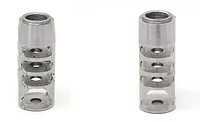Holistic Wheel Coating Wizardry
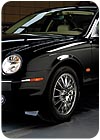
Since the inception of powder coating technology, finishers have clamored for a "chrome look" powder coating. Bright metallics are achievable, but their luster never approximates that of a chrome plated finish. Chrome plating involves the use of hexavalent chrome, which is considered a heavy metal that has long been recognized as a human carcinogen. No problem, thought the wheel manufacturers, we can outsource our plating needs overseas, thereby shifting the worker exposure burden to developing nations with looser environmental regulations. No problem indeed - until the car makers realized that placing chrome plated wheels on autos still created environmental liability after the car met its eventual fate at the salvage yard. Disposed autos could potentially leach chrome into the ground and therefore contaminate aquifers destined for drinking water or crop irrigation.
Perhaps chrome plating overseas is not the answer.
A New Program
Recognizing the need to offer the automotive wheel industry an environmentally sound alternative to chrome plating, Marshall Leininger, an automotive powder product manager at Seibert Powder Coatings at the time, conceptualized a technology that provides a truly chrome look using an environmentally friendly process. He envisioned cherry-picking the outstanding features of powder coating, UV cure and metallizing technology to accomplish this mission. His premise originated with the thought that the metallizing process has been successfully established using plastic substrates; why couldn't the same technique be applied to an organic powder surface? Isn't the cured powder very similar in nature to a plastic surface?Leininger conducted feasibility studies to test his theory. Not surprisingly, his lab work yielded positive results. However, Leininger understood that successfully commercializing the process would require a system composed of many sub-processes and materials, combined with a holistic approach.
His boss, Sam Rhue, the president of Seibert Powder, realized that undertaking a multifaceted program such as this was outside the realm of Seibert's mission, so he encouraged Marshall to become independent in his quest to commercialize this process. Seibert recognized the potential of this concept and made a commitment to support the program from a powder technology standpoint.
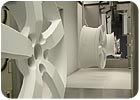
The Approach
Requiring funds to jumpstart this venture, Leininger turned to his brother, Mark, an expert in the investment arena. Mark reviewed the business plan and was immediately sold on its viability. Capital was raised, and a new company, Helios Coatings, Inc., was established in June 2004.First on the agenda was to establish a consortium of the right technology partners to fit the pieces of the puzzle together. They had to be reputable organizations well ensconced in the automotive industry. Furthermore, they had to be nimble enough to provide the needed response to a dynamic, technically challenging program. Seibert Powder Coatings had already pledged its support for powder development, but a resin company was needed to support Seibert's efforts if new polymer technology was required. Helios Coatings chose Anderson Development, Adrian, Mich., which is well known for its automotive acrylic resin technology.
An organization well versed in UV lamp technology was also needed. Fusion Systems, Gaithersburg, Md., came on board because of its extensive expertise in automotive UV curing systems and its reputation as a keen supporter of new technology.
For metallizing technology, Marshall turned to Automated Vacuum Systems, Inc., Sarasota, Fla., a company that has extensive expertise in metallizing for automotive lighting components, as well as leadership in a variety of industrial applications.
Next on the agenda was finding a partner that could provide liquid UV technology. Red Spot Paint, Evansville, Ind., is a privately held coatings company known for its nimbleness and innovative automotive UV technology. The company gladly committed resources to further the Helios technology.
Helios also needed an equipment company to engineer the conveyor and UV application system. It chose Nutro Corp., Strongsville, Ohio, for its great reputation for innovation in both UV and powder application technology.
Part of the task of starting a new venture is keeping both operating and capital costs to a minimum. Marshall learned that a relatively new wheel coating system in Howell, Mich., was being shut down. He seized the opportunity and was able to acquire its pretreatment and powder application systems for the price of dismantling them.
Marshall had spent more than 10 years of his life in technical service in the fast-paced automotive industry. His job required him to travel extensively and work very long hours away from home. Marshall's dream was to establish his new venture a reasonable bike ride from his home in Canton, Ohio. With the guidance and financial incentives of both local and state organizations, he set up shop in a building of a recently closed printing company in Canton. Many jobs had been lost due to the demise of this local corporate fixture. Marshall was inspired with the prospect of creating new jobs for his local community.

Development of the Process
The development work was conducted in a fully outfitted coating laboratory specifically designed by Marshall. Samples could be prepared and tested for cure response and for film performance, and both single wheel specimens and test panels could be handled within this laboratory setting.The first step was a high quality nine-stage pretreatment process provided by GE-Water & Process Technologies, Trevose, Pa., a system that has been approved by the major automotive companies for use on aluminum alloy wheels.
Leininger's hunch that metallizing could work on a cured powder surface proved correct. In most cases, a properly formulated powder could accept a physical vapor deposition (PVD) metal layer. Seibert Powder, which provided the powder primer technology, decided that the powder had to be able to meet all of the wheel coating specifications as a stand-alone finish, even though the coating would be subsequently coated with at least a couple more coating layers.
The metallizing was applied to this durable coat. In some cases, the powder finish would physically shift on a microscopic level, causing the metallizing to wrinkle or crack. After much painstaking lab work, Helios' engineers realized that applying a thin coat of specially formulated UV cured liquid on the surface of the powder completely eliminated the metal wrinkling.
Red Spot Paint was enlisted to develop the UV liquid sealer coat. The company quickly crafted a material that eliminated the tendency of the metal layer to move and thereby fixed the problem. Nutro Corp. designed and installed the apparatus to apply and cure the UV sealer.
If left unprotected, the bright metallic layer will quickly oxidize, thereby killing its luster and rendering the finish unacceptable. The final step therefore involves applying a durable acrylic powder clearcoat to the metallized surface. Seibert already had extensive expertise in automotive clearcoats through its participation in the Low Emissions Paint Consortium (LEPC), where it developed clears for automotive bodies. This technology was used as the platform to develop a highly durable powder to protect the metallized wheels.
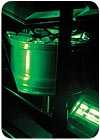
The Performance
Throughout the development and refinement process, coated wheel samples were extensively tested per the prevailing automotive wheel specifications. Plated wheel samples were used as controls. Wheels processed with the new technology - which Helios named Metallight™ - passed all of the OEM specifications with flying colors.One significant performance advantage over plating was identified during this testing. Automotive coatings engineers run a severe test called CASS (copper accelerated acetic acid salt spray) to gauge corrosion resistance. The test is typically run for 200 hours. The Helios team learned that the new technology significantly outperformed the plated samples in this test.
The technology also easily passed other performance requirements for hardness, flexibility, chip resistance and resistance to outdoor conditions.
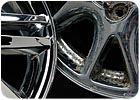
The Market
Originally, Leininger and his team focused on original equipment manufacturers (OEMs) as their targeted market for the new technology. It was perhaps a bit of serendipity that led them to uncover a new, much more receptive destination for their novel product. Marshall and his marketing expert, Michael Barrett, attended the National Automotive Dealers Association (NADA) show in Orlando, where they were surprised to learn that the car dealerships had an immediate need for high-quality aftermarket wheels. In fact, some asked how soon Helios could ship wheels to their dealerships.Leininger and Barrett headed back to Ohio with a newfound sense of purpose. Their assumption to first target the OEMs made sense; however, the aftermarket opportunities were much more instantaneous. This key development accelerated Helios' commercialization.
Soon wheels were flying off their pilot line and heading to paying customers. Through these relationships, Helios developed a program in which used wheels from dealerships are stripped and coated using the Metallight process. This program has gained widespread acceptance and is expanding on a monthly basis.
In the meantime, the OEMs continue to conduct their approval process.
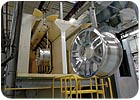
The Future
Leininger, now chief operating officer of Helios Coatings, recognizes that the operation is more of a pilot line than a full-fledged production facility. While the company can handle the demands of its current customers, Helios' capacity will soon fill and require a major expansion. Plans are under way to meet the needs of this blossoming market.One thing is for sure - it doesn't always take the army or a mammoth organization to accomplish truly amazing technology. A dedicated cadre of experts engaged in a holistic approach to multi-faceted technology can make miracles happen.
Helios Coatings, Inc., can be reached at (330) 430-9990 or www.helioscoatings.com. Links to the other companies referenced in this article can be found online at www.paintandpowder.com.
For information on reprints of this article, contact Jill DeVries at devriesj@bnpmedia.com.
Links
Looking for a reprint of this article?
From high-res PDFs to custom plaques, order your copy today!




